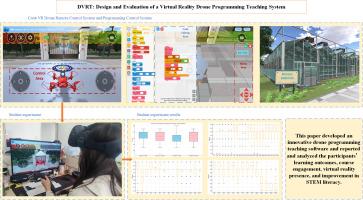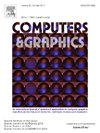DVRT: Design and evaluation of a virtual reality drone programming teaching system
IF 2.5
4区 计算机科学
Q2 COMPUTER SCIENCE, SOFTWARE ENGINEERING
引用次数: 0
Abstract
Virtual Reality (VR) is an immersive virtual environment generated through computer technology. VR teaching, by utilizing an immersive learning model, offers innovative learning methods for Science, Technology, Engineering and Mathematics (STEM) education as well as programming education. This study developed a Drone Virtual Reality Teaching (DVRT) system aimed at beginners in drone operation and programming, with the goal of addressing the challenges in traditional drone and programming education, such as difficulty in engaging students and lack of practicality. Through the system's curriculum, students learn basic drone operation skills and advanced programming techniques. We conducted a course experiment primarily targeting undergraduate students who are beginners in drone operation. The test results showed that most students achieved scores above 4 out of 5, indicating that DVRT can effectively promote the development of users' comprehensive STEM literacy and computational thinking, thereby demonstrating the great potential of VR technology in STEM education. Through this innovative teaching method, students not only gain knowledge but also enjoy the fun of immersive learning.

DVRT:虚拟现实无人机编程教学系统的设计与评估
虚拟现实(VR)是通过计算机技术生成的一种身临其境的虚拟环境。虚拟现实教学通过利用沉浸式学习模式,为科学、技术、工程和数学(STEM)教育以及编程教育提供了创新的学习方法。本研究针对无人机操作和编程初学者开发了无人机虚拟现实教学(DVRT)系统,旨在解决传统无人机和编程教育中学生难以参与、缺乏实用性等难题。通过该系统的课程,学生可以学习基本的无人机操作技能和高级编程技术。我们主要针对初学无人机操作的本科生进行了课程实验。测试结果显示,大多数学生的成绩都在 4 分(满分 5 分)以上,这表明 DVRT 能够有效促进用户的 STEM 综合素养和计算思维的发展,从而展示了 VR 技术在 STEM 教育中的巨大潜力。通过这种创新的教学方法,学生们不仅获得了知识,还享受到了身临其境的学习乐趣。
本文章由计算机程序翻译,如有差异,请以英文原文为准。
求助全文
约1分钟内获得全文
求助全文
来源期刊

Computers & Graphics-Uk
工程技术-计算机:软件工程
CiteScore
5.30
自引率
12.00%
发文量
173
审稿时长
38 days
期刊介绍:
Computers & Graphics is dedicated to disseminate information on research and applications of computer graphics (CG) techniques. The journal encourages articles on:
1. Research and applications of interactive computer graphics. We are particularly interested in novel interaction techniques and applications of CG to problem domains.
2. State-of-the-art papers on late-breaking, cutting-edge research on CG.
3. Information on innovative uses of graphics principles and technologies.
4. Tutorial papers on both teaching CG principles and innovative uses of CG in education.
 求助内容:
求助内容: 应助结果提醒方式:
应助结果提醒方式:


